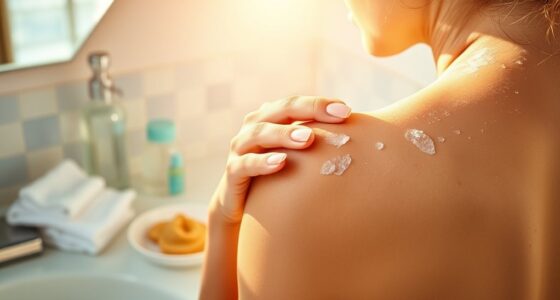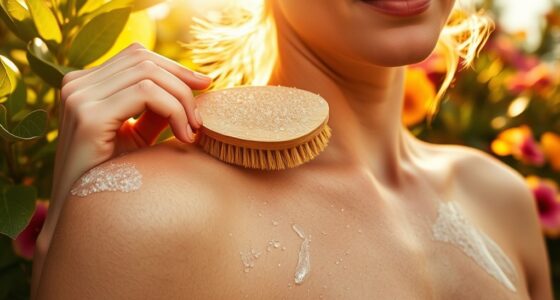To protect yourself this summer, always choose a broad-spectrum sunscreen with at least SPF 30, and remember to reapply every two hours. Don't forget to cover commonly missed areas like your ears and tops of your feet. Wear protective clothing rated UPF 50+ and accessorize with a wide-brimmed hat and UV-blocking sunglasses. Stay in the shade during peak hours, between 10 a.m. and 4 p.m., to minimize exposure. Finally, keep hydrated to support your skin's health. You'll uncover even more essential tips and strategies to enhance your sun protection as you explore further.
Key Takeaways
- Use broad-spectrum sunscreen with at least SPF 30 and reapply every two hours for optimal protection against UV rays.
- Wear UPF 50+ clothing, wide-brimmed hats, and sunglasses to shield your skin and eyes from harmful sun exposure.
- Stay in the shade during peak sun hours (10 a.m. – 4 p.m.) to significantly reduce UV exposure.
- Hydrate regularly, as proper hydration supports skin health, especially in hot weather.
Importance of Sun Protection
Sun protection is essential because even brief exposure to UV rays can lead to serious skin damage and increase your risk of skin cancer. One in five Americans will develop skin cancer by age 70, making sun safety a top priority for everyone. UV rays can cause not only sunburn but also premature aging and long-term skin issues.
It's important to remember that UV rays can penetrate clouds, so even on overcast days, you need to protect your skin. Consistent sun safety measures, like wearing protective clothing with a UPF rating of 40 or higher, can give you the same protection as SPF 30 sunscreen.
Additionally, staying in the shade during peak sun hours, typically between 10 a.m. and 4 p.m., can greatly reduce your exposure to harmful UV rays. Incorporating these strategies into your daily routine can help safeguard your skin from damage while enjoying outdoor activities.
Sunscreen Selection Tips

When picking a sunscreen, you need to focus on broad-spectrum products that shield against both UVA and UVB rays.
It's also essential to choose an SPF of at least 30 for effective protection.
Don't forget to take into account your skin type—finding the right formula makes it easier to stick to your sun protection routine.
Broad-Spectrum Importance
Choosing a broad-spectrum sunscreen with an SPF of 30 or higher is crucial for protecting your skin from harmful UVA and UVB rays. These rays can cause skin damage and increase your risk of skin cancer. When selecting a sunscreen, keep the following tips in mind for ideal broad-spectrum protection:
- Look for water-resistant formulations if you plan to swim or sweat, ensuring your sunscreen stays effective longer.
- Always check the expiration date on your sunscreen. Expired products may not provide the protection you need.
Make it a habit to apply sunscreen generously to all exposed skin 15 minutes before sun exposure.
Don't forget to reapply every two hours or immediately after swimming or sweating. This routine helps maintain that crucial broad-spectrum protection.
When you choose the right sunscreen, you're not just shielding your skin; you're investing in your long-term health.
SPF Selection Guidelines
Selecting the right SPF is vital for guaranteeing your skin stays protected from harmful rays during outdoor activities. When choosing your sunscreen, opt for a broad-spectrum formula with an SPF of 30 or higher. This level of protection helps shield you from both UVA and UVB rays, essential for preventing sunburn and long-term skin damage.
If you plan to swim or engage in activities that cause sweating, look for water-resistant options. These formulations help maintain their effectiveness even when exposed to moisture.
Don't forget to check the expiration date on your sunscreen; expired products may not offer adequate protection, leaving your skin vulnerable.
Skin Type Considerations
Understanding your skin type is vital for finding the sunscreen that best suits your needs and offers effective protection against harmful UV rays. Choosing the right product can greatly reduce the risk of skin damage while enjoying the summer sun.
If you have fair skin, opt for a mineral sunscreen with at least SPF 50 to minimize burning.
Acne-prone or oily skin benefits from lightweight, oil-free, gel-based sunscreens that won't clog pores.
Sensitive skin types should consider mineral options with zinc oxide or titanium dioxide to avoid irritation.
Don't forget that darker skin tones also need protection. A broad-spectrum SPF of 30 or higher is essential to prevent issues like hyperpigmentation.
For those with dry skin, look for moisturizing sunscreens that contain hydrating ingredients like hyaluronic acid or glycerin.
Lastly, remember that sunscreen is just one part of your sun protection strategy.
Pair it with protective clothing and seek shade to further shield your skin from harmful UV rays.
Effective Application Techniques

When it comes to sunscreen, applying it generously is essential for effective protection.
You'll need to reapply every two hours and pay attention to commonly missed areas like your ears and neck.
Generous Application Guidelines
To guarantee your sunscreen works effectively, apply it generously at about two milligrams per square centimeter of skin. This amount guarantees that you get the right level of protection against UV rays.
For ideal absorption, make sure to apply your sunscreen 15-30 minutes before heading out into the sun. This allows the ingredients to bind to your skin properly.
Remember these key points for effective application:
- Don't neglect commonly missed areas like your ears, neck, lips, and the tops of your feet.
- Use protective clothing and seek shade during peak sun hours, typically between 10 a.m. and 4 p.m.
Reapplication Frequency Importance
Reapplying sunscreen every two hours is essential for maintaining effective protection against harmful UV rays. This is especially important if you're swimming or sweating a lot, as these activities can wash away your sun protection. To guarantee you're getting the most out of your sunscreen, apply about two milligrams per square centimeter of skin, which translates to roughly one ounce for an average adult.
Even on cloudy days, don't skip reapplication; up to 80% of UV rays can still penetrate clouds, putting your skin at risk. By making it a habit to reapply every two hours, you're not just preventing sunburn but also protecting against long-term skin issues like premature aging and skin cancer.
Incorporating regular reapplication into your outdoor routine is key. Set a timer on your phone or carry a travel-size sunscreen in your bag to remind you. When you're consistent with this practice, you maximize your sun protection, allowing you to enjoy your time outdoors without worry.
Commonly Missed Areas
Have you ever noticed how easily you can overlook certain areas while applying sunscreen? It's common to focus on your face and arms, but neglecting commonly missed areas can lead to painful sunburns. To guarantee effective sun protection, pay close attention to these often-forgotten spots:
- Ears: These are highly exposed and can burn quickly.
- Back of the knees: A spot that's usually ignored, yet it gets plenty of sun.
When applying sunscreen, use about two milligrams per square centimeter for ideal coverage. Make sure you apply liberally, especially to those overlooked areas.
And remember to reapply every two hours or sooner if you're sweating or swimming. For added protection, consider using lip balm with SPF for your lips, which are also commonly missed but very vulnerable to UV damage.
You might also want to wear protective clothing like long sleeves or rash guards for extra coverage.
Mineral Vs. Chemical Sunscreens

Mineral and chemical sunscreens each offer distinct benefits, making it essential to choose the right one for your skin type and lifestyle.
Mineral sunscreens contain active ingredients like zinc oxide and titanium dioxide, providing immediate physical protection by reflecting UV rays. They're often recommended for sensitive skin types since they're less likely to irritate. If you're looking for a sunscreen that's gentle and effective, mineral options might be your best bet.
On the other hand, chemical sunscreens absorb UV radiation and convert it into heat, which is then released from the skin. This typically requires about 20 minutes to become effective, so plan accordingly. They usually feature a lighter texture and are less likely to leave a white cast, making them a popular choice for everyday wear under makeup.
When deciding between mineral and chemical sunscreens, consider your skin sensitivities, how you want the product to feel on your skin, and even the environmental impact of certain chemical ingredients.
Ultimately, the best sunscreen for you will align with your personal preferences and lifestyle needs.
Daily Consistency in Sun Care

To effectively protect your skin from harmful UV rays, applying sunscreen daily—regardless of the weather—is non-negotiable. Many people mistakenly believe that they only need sunscreen on sunny days, but UV rays can penetrate clouds and still cause damage. Consistency in your sun care routine is crucial to prevent skin damage and premature aging.
Here are a few tips to help you stay consistent:
- Reapply every two hours: Make it a habit to reapply sunscreen every two hours, or immediately after swimming or sweating, to maintain ideal protective benefits.
- Incorporate SPF into your skincare: Using moisturizers with SPF can provide hydration while ensuring your skin remains protected daily.
Protective Clothing and Accessories

Wearing protective clothing and accessories is crucial for shielding your skin from harmful UV rays during outdoor activities. Sun-protective clothing rated with a UPF (Ultraviolet Protection Factor) of 50+ blocks 98% of UV rays, making it ideal for those long summer days. Opt for long-sleeved shirts and tightly woven pants to cover more skin and reduce direct sun exposure. Unlike regular fabrics that offer minimal SPF protection, UPF clothing retains its protective qualities even after multiple washes.
Don't forget about accessories! A wide-brimmed hat can provide shade for your face and neck, while legionnaire-style hats offer extra neck coverage, greatly enhancing your protection against UV radiation.
When it comes to your eyes, choose sunglasses that block 100% of UVA and UVB rays. Look for a UV 400 label to guarantee you're getting the best eye protection.
Hydration and Skin Health

Staying hydrated is key to maintaining healthy skin, especially during the hot summer months.
Without enough water, you might experience signs of dehydration like headaches and fatigue, which can take a toll on your skin's appearance.
Let's explore some effective hydration tips to keep your skin looking its best while enjoying the sun.
Importance of Hydration
Hydration plays an essential role in maintaining your skin's health, especially during the sweltering summer months when the risk of dehydration is higher. When you don't drink enough water, your skin can become dry, sensitive, and less elastic, which can lead to an increase in fine lines and wrinkles. By prioritizing hydration, you not only support your skin protection but also enhance your overall appearance.
Here are a few key points to remember about hydration and skin health:
- Moisture Balance: Drinking enough water helps maintain your skin's moisture balance, keeping it plump and radiant.
- Barrier Function: Proper hydration supports your skin's barrier function, which protects against environmental stressors.
Make sure to carry a large water bottle with you, and sip regularly throughout the day. Your skin will thank you for the extra care, especially when the sun is blazing down. Stay hydrated, and enjoy a summer full of healthy, glowing skin!
Signs of Dehydration
Recognizing the signs of dehydration is essential for maintaining your skin's health, especially during the hot summer months when fluid loss can occur rapidly. When you're dehydrated, your body may signal this through various symptoms. Headaches, dry mouth, fatigue, and dark yellow urine are all indicators that you need to increase your fluid intake.
The risk of dehydration rises considerably in warm weather, particularly for children and older adults who are more susceptible to heat-related illnesses. It's important to monitor your hydration status by checking for decreased urine output or feelings of thirst—these are early signs that you need to hydrate.
To maintain effective skin protection, carry a large water bottle during outdoor activities. This can help remind you to drink regularly throughout the day, reducing the chances of dehydration. For children, aim for 5 to 7 cups of water daily, depending on their age and activity level.
Hydration Tips for Summer
To keep your skin healthy and radiant during the summer, make it a habit to drink plenty of water throughout the day. Staying hydrated is vital not just for your overall well-being but also for skin protection against the sun's harsh effects. Dehydration can lead to symptoms like headaches and dry skin, making it essential to monitor your fluid intake, especially in hot weather.
Here are some tips to enhance your hydration:
- Carry a water bottle: Make it easy to sip throughout the day, especially during outdoor activities.
- Limit sugary and caffeinated drinks: These can contribute to dehydration, so stick to water whenever possible.
Aim for about 2.7 liters for women and 3.7 liters for men daily, adjusting for activity levels and heat. By prioritizing hydration, you not only support your body but also boost your skin's health, keeping it glowing and protected all summer long.
Eye Protection Essentials

Sunglasses are crucial for protecting your eyes from harmful UV rays, so choosing the right pair is essential for summer sun safety. Look for sunglasses that provide 100% UV protection or have a UV 400 label, which guarantees effective shielding from both UVA and UVB rays.
Remember, the darkness of the lens doesn't determine UV protection—clear lenses can also offer adequate coverage if treated properly. You don't need to spend a fortune; affordable sunglasses can deliver the same level of UV protection as expensive brands, as long as they meet necessary standards.
Comfort is key, too; make sure your sunglasses fit snugly to prevent UV rays from sneaking in around the edges. This snug fit helps guarantee complete eye protection while you enjoy the sunshine.
Lastly, don't forget to regularly check your sunglasses for UV protection through optician testing. Over time, lenses can degrade, diminishing their protective qualities. By prioritizing these eye protection essentials, you'll keep your eyes safe and enjoy your summer adventures without worry.
Planning Outdoor Activities

When planning outdoor activities, aim to schedule them during the early morning or late afternoon to steer clear of the sun's peak intensity. The strongest UV rays typically occur between 10 a.m. and 4 p.m., so adjusting your plans can greatly enhance your skin protection.
Before you head out, be sure to check the UV index for your area. High levels of UV radiation can lead to severe skin damage, particularly in places like Las Vegas.
Also, incorporate shade into your activities; use umbrellas, tents, or find natural shade from trees to minimize direct sun exposure.
Don't forget to stay hydrated! Carry water bottles and encourage everyone to drink regularly, especially during active events in hot weather.
Remember these key points:
- Pack sunscreen with at least SPF 30 to safeguard your skin.
- Wear hats and UV-protective clothing to enhance your defense against harmful rays.
Addressing Common Myths

Many people hold misconceptions about sun protection that can lead to inadequate safety measures while enjoying outdoor activities.
One common myth is that sunscreen isn't necessary on cloudy days. In reality, about 80% of UV rays can still penetrate clouds, so applying sunscreen remains vital even when the sky is gray.
Another myth is the belief that a base tan offers protection from burns. Tanning is actually a sign of skin damage, and relying on it as a shield against UV exposure is ineffective.
You might also think darker skin tones require less protection, but that's misleading. While darker skin has more melanin, it can still suffer UV damage, so everyone should use sunscreen.
Additionally, some believe sunscreen is only important during summer. UV rays can harm your skin year-round, making it essential to protect yourself regardless of the season.
Lastly, many assume that SPF ratings over 30 provide considerably more protection. However, SPF 30 blocks about 97% of UVB rays while SPF 50 only blocks approximately 98%. This shows diminishing returns for higher SPF numbers, so choose wisely and stay protected!
Frequently Asked Questions
What Is the #1 Best Sunscreen?
The best sunscreen you can choose is broad-spectrum with an SPF of 30 or higher. It protects against both UVA and UVB rays, ensuring your skin stays safe during sun exposure. Remember to reapply regularly!
What Sunscreen Does the FDA Recommend?
When it comes to sunscreen, think of it as your shield against the sun's harsh rays. The FDA recommends broad-spectrum sunscreens with SPF 30 or higher for effective protection. Don't forget to check expiration dates!
Which Brand Is Best for Sunscreen?
When choosing a sunscreen brand, consider Neutrogena, Coppertone, or Banana Boat for effective options. If you prefer mineral-based formulas, Blue Lizard or Thinkbaby are great for sensitive skin. Always check for broad-spectrum protection and water resistance.
What Forms of Sun Protection Are Most Effective?
To effectively protect yourself from the sun, use broad-spectrum sunscreen with SPF 30+, wear UPF clothing, don wide-brimmed hats and UV-protective sunglasses, seek shade during peak hours, and reapply sunscreen regularly.
How Can I Ensure My Kids Stay Protected from the Sun during Summer?
Ensure your kids stay protected from the sun during summer by using fun ways to teach kids about sun safety. Encourage them to wear sunscreen, hats, and sunglasses while playing outdoors. Make it a game to reapply sunscreen every few hours and seek shade during peak UV hours.
Conclusion
As you enjoy those sunny days, remember that sun protection isn't just a choice; it's a necessity.
Coincidentally, the simple act of applying sunscreen could mean the difference between a carefree summer and skin troubles down the line.
You've got the tools to protect yourself—take them seriously! Embrace the warmth, but don't forget your skin deserves the best care.
So, gear up and make sun safety a part of your daily routine, ensuring each summer is a joyful one.









